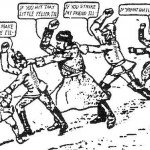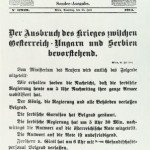
The July crisis of 1914 was a chain reaction of events that led to declarations of war by the Great Powers of Europe. The murder of an Austro-Hungarian royal sparked an immediate response from Vienna. Princip and his collaborators testified that they had acted independently, without the knowledge or assistance of the Serbian government. Most in the Austro-Hungarian empire did not believe this and attributed the killings to Serbia and its leaders. Even if they did not order the assassination plot, they were complicit in allowing nationalist and terrorist groups to flourish within their borders. Austrian investigators unearthed circumstantial evidence that some of the group had received training from a Serbian military officer. Meanwhile, ‘hawks’ in the Austro-Hungarian imperial government saw the incident as a grand opportunity to invade Serbia and decisively crush its rebellious elements.
The month-long period following the assassination became known as the ‘July crisis’. It drew in most of the major political leaders of Europe, in some form or another; some sought to avoid war while others seemed hell-bent on firing the first shots in one. There was a flurry of meetings between Austro-Hungarian and German diplomats, where they debated how to proceed and what might happen with regard to Russia if Vienna declared war on Serbia. On July 5th Kaiser Wilhelm II issued his famous ‘blank cheque’ to the Austro-Hungarians: they could proceed as they saw fit, and Germany would back them if Russia intervened. Privately, Wilhelm and his military chief, von Moltke, wanted war with Russia and France sooner rather than later. Both believed Germany to be much better prepared than the Russians and the French; they wanted to strike early before both could adequately mobilise. The kaiser urged his Austrian allies to deal with Serbia promptly and ruthlessly. He did not believe the Russians would declare war on Austria-Hungary, but if they did, Germany would reciprocate with a declaration of war against Saint Petersburg. After the conclusion of this agreement Wilhelm and several Austrian politicians went on holiday – a deliberate ploy to suggest their disinterest in the crisis.
“The cult of the offensive encouraged German and Austrian expansionism that led to the crisis of July 1914 and to the war. The Germans probably preferred the status quo to a world war against the entire Entente, and they would not have fomented the July 1914 crisis had they known that a world war would result. In my judgement, the Germans did want a confined continental war against France and Russia; and many among the German elite supported the instigation of the July crisis in hopes of provoking just such a war. Moreover, German leaders recognised and accepted the risk that this might entail a wider war against Britain and Belgium.”
Kenneth A. Oye, historian
On July 23rd, almost one month after the assassination, the Serbian government received an ultimatum from Austria-Hungary. In it was a set of ten firmly worded demands, plus a requirement for the Serbs to respond in agreement within 48 hours. Winston Churchill, then in charge of Britain’s Royal Navy, called the ultimatum “the most insolent document of its kind ever devised”. Among the demands made by the Austro-Hungarians upon Serbia were:
- The banning of Serbian publications which had been responsible for anti-Austrian propaganda.
- The removal of anti-Austrian individuals from the Serbian military, government and civil service.
- The removal of Serbian teachers and curriculum that had promoted or incited anti-Austrian feeling.
- The outlawing and disbanding of the Serbian nationalist group Narodna Odbrana (‘People’s Defense’).
- A crackdown on cross-border arms trading and the removal of corrupt border officials.
- A joint Serbian-Austrian investigation into the assassination plot, conducted within Serbia by Austrian officials, and involving the investigation and interrogation of Serbian civilians and military personnel.

Serbia immediately sought the counsel of the Russians. Tsar Nicholas II and his ministers offered to publicly condemn the ultimatum – but they were also aware that Russia’s military readiness lagged behind Germany’s, so refused to offer any military guarantees. The British foreign minister tried averting war by organising a mediation conference between all nations with a stake in the crisis – but this was rejected by both Berlin and Vienna. Serbia responded to the Austrian ultimatum just before the expiration of the deadline. It submitted to most of the demands but rejected the Austrian-led inquiry demanded by point six, which it considered a breach of Serbian sovereignty. The Serbs again reiterated that their government gave no moral or materiel support to Princip and the other assassins. The Austrian ambassador, on receiving the Serbian response, read it once, then immediately left Belgrade and returned to Vienna. After some cajoling from his advisors, Austro-Hungarian emperor Franz Josef declared war on Serbia on July 28th.
The declaration of war triggered a chain reaction that quickly dragged in the nations of Europe. Bound by their alliances – or rather their leaders’ commitment to these agreements – country after country was drawn into the spiral of war. Russia, a long-time protector of Serbia, responded by mobilising its forces against Austria-Hungary. Germany’s rulers declared war on Russia on August 1st and lit the fuse for their much-anticipated Schlieffen Plan, a scheme to invade France, which began the following day. Germany’s invasion of neutral Belgium triggered Britain’s involvement, which in turn dragged British dominions – Australia, New Zealand, Canada, India and South Africa – to declare war on Germany. By the end of August most of Europe was at war, though a few countries (Switzerland, Sweden, Norway, Spain and the Netherlands) remained neutral for the duration.
As might be expected, the first military action occurred in Serbia, where Austro-Hungarian troops crossed the border to occupy its July prey. But the Austro-Hungarian aggressors did not fare as well as they had anticipated, due to some stubborn Serbian resistance compounded by blunders by their own generals. By early August German forces were implementing the Schlieffen Plan, marching into northern France through neutral Belgium and Luxembourg, while another German contingent in the east secured a comprehensive victory over the Russians at Tannenburg. Elsewhere there was little fighting in the first month, as most belligerents put their energy into mobilisation (the recruitment, training, equipping and movement of their armies).

1. The July crisis was a month-long period of ultimatums and threats that led to the outbreak of World War I.
2. It began with negotiations between allies about whether to back each other in the event of mobilisation or war.
3. Encouraged by German backing, the Austro-Hungarian government issued Serbia with an extensive ultimatum.
4. The Serbians accepted most but not all of these terms, leading to an Austro-Hungarian declaration of war.
5. This prompted Russia to order the mobilisation of its forces, in preparation for a possible war against Austria-Hungary; this led to Germany following suit and declarations of war in late July and early August 1914.
© Alpha History 2014. Content on this page may not be republished or distributed without permission. For more information please refer to our Terms of Use.
This page was written by Jennifer Llewellyn, Jim Southey and Steve Thompson. To reference this page, use the following citation:
J. Llewellyn et al, “The July Crisis” at Alpha History, https://alphahistory.com/worldwar1/july-crisis/, 2014, accessed [date of last access].
